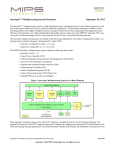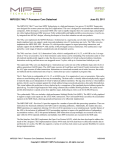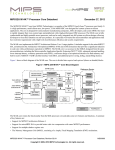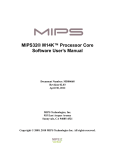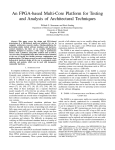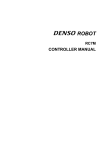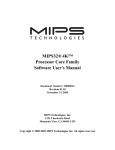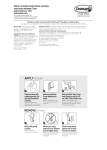Download MIPS32® 34Kc™ Processor Core Datasheet
Transcript
MIPS
Verified
MIPS32® 34Kc™ Processor Core Datasheet
™
November 19, 2010
The MIPS32® 34Kc™ core from MIPS Technologies is a high-performance, low-power, 32-bit MIPS RISC core designed for
custom system-on-silicon applications. The core is designed for semiconductor manufacturing companies, ASIC developers,
and system OEMs who want to rapidly integrate their own custom logic and peripherals with a high-performance RISC
processor. Fully synthesizable and highly portable across processes, it can be easily integrated into full system-on-silicon
designs, allowing developers to focus their attention on end-user products. The MIPS32® 34Kn™ core is a family variant of
the MIPS32® 34Kc™ which includes several several features to mitigate performance degradataion when using small cache
sizes, so as to facilitate massively parallel systems.
The 34Kc CPU implements the MIPS32 Release 2 Architecture. In addition to the base architecture, it features the following
application specific extensions (ASE):
• The MIPS MT ASE which defines multi-threaded operation.
• The MIPS DSP ASE which provides support for signal processing instructions.
• The MIPS16e™ ASE which reduces code size
This standard architecture allows support by a wide range of industry standard tools and development systems.
The MT ASE allows the CPU to operate more efficiently by executing multiple program streams concurrently. The CPU can be
configured with 1 or 2 Virtual Processing Elements (VPEs), each of which contain much of the privileged coprocessor 0 state,
including a full Memory Management Unit (MMU), to allow multiple OSes to operate concurrently on the processor.
Additionally, the core can be configured to have from 1-9 Thread Contexts (TCs). A TC consists of a register file, a Program
Counter, and a limited amount of privileged state. TCs offer lightweight multi-threading to allow cooperative or independent
threads to run concurrently.
The DSP ASE provides support for a number of powerful data processing operations. There are instructions for fractional
arithmetic (Q15/Q31) and for saturating arithmetic. Additionally, for smaller data sizes, SIMD operations are supported,
allowing 2x16b or 4x8b operations to occur simultaneously. Another feature of the ASE is the inclusion of additional HI/LO
accumulator registers to improve the parallellization of independent accumulation routines.
The synthesizable 34Kc CPU includes a high performance Multiply/Divide Unit (MDU) by default. The MDU is fully pipelined
to support a single cycle repeat rate for 32x32 MAC instructions. Further, in the 34Kc Pro™ CPU, the optional CorExtend block
can utilize the HI/LO registers in the MDU block. The CorExtend block allows specialized functions to be efficiently
implemented.
Instruction and data level one caches are configurable at 0, 8, 16, 32, or 64 KB in size. Each cache is organized as 4-way set
associative by default. Data cache misses are non-blocking and up to 8 may be outstanding. Two instruction cache misses can
be outstanding. Both caches are virtually indexed and physically tagged to allow them to be accessed in the same cycle that the
address is translated. To achieve high frequencies while using commercially available SRAM generators, the cache access is
spread across two pipeline stages, dedicating nearly an entire cycle for the SRAM access.
The Bus Interface Unit implements the Open Core Protocol (OCP) which has been developed to address the needs of SOC
designers. This implementation features 64-bit read and write data buses to efficiently transfer data to and from the L1 caches.
The BIU also supports a variety of core/bus clock ratios to give greater flexibility for system design implementations.
MIPS32® 34Kc™ Processor Core Datasheet, Revision 01.21
Copyright © 2005-2010 MIPS Technologies Inc. All rights reserved.
MD00418
An Enhanced JTAG (EJTAG) block allows for software
debugging of the processor. This includes a TAP controller
with PC sampling and Fast Debug Channel features. Optional
features include instruction and data trace as well as
instruction and data virtual address/value breakpoints.
Figure 1
2
Figure 1 shows a block diagram of the 34Kc CPU. The
dashed boxes indicate blocks that can be modified by the
customer for specific applications.
34Kc™ CPU Block Diagram
MIPS32® 34Kc™ Processor Core Datasheet, Revision 01.21
Copyright © 2005-2010 MIPS Technologies Inc. All rights reserved.
EJTAG
CorExtend
MT
control
blocks
I-cache
8-64KB
4 way set associative
MDU
PDTrace
TAP
EJTAG
Off-Chip
Debug I/F
Scratchpad
RAM
TC
Dispatch
Unit
MMU (per VPE)
16-64 entry
JTLB or FMT
BIU
4 entry
merging write
buffer, 6-10
outstanding
reads
OCP Interface
On-Chip Bus(es)
Execution
Unit (RF per
TC, ALU,
Shift, etc)
Fetch Unit
Non blocking
Load/Store Unit
4-8 outstanding misses
CP2
System
Coprocessor
D-cache
8-64KB
4 way set associative
Power
Mgmt
Scratchpad
RAM
Inter-Thread
Communication
Unit
MIPS32® 34Kc™ Processor Core Datasheet, Revision 01.21
Copyright © 2005-2010 MIPS Technologies Inc. All rights reserved.
3
34Kc™ CPU Features
• 8-9-stage pipeline (a thread selection stage is bypassed
on single-TC CPUs, yielding 8 stages)
• 32-bit address paths
• 64-bit data paths to caches and external interface
• MIPS32 Release2 Instruction Set and Privileged
Resource Architecture
• MIPS16e™ Code Compression (optional)
• MIPS MT Application Specific Extension (ASE)
– Support for 1 or 2 Virtual Processing Elements
(VPEs)
– Support for 1-9Thread Contexts (TCs)
– Inter-Thread Communication (ITC) memory for
efficient communication & data transfer.
• MIPS DSP ASE (optional)
–
–
–
–
3 additional pairs of accumulator registers.
Fractional data types (Q15, Q31)
Saturating arithmetic
SIMD instructions operate on 2x16b or 4x8b
simultaneously.
• Programmable Memory Management Unit
–
–
–
–
–
–
–
–
–
–
–
–
–
–
–
–
16/32/64 dual-entry JTLB per VPE
JTLBs are sharable under software control
4-12 entry MT-optimized ITLB
8-entry DTLB
Optional simple Fixed Mapping Translation (FMT)
mechanism
Programmable L1 Cache Sizes
Individually configurable instruction and data caches
4-Way Set Associative sizes of 4/8/16/32/64 KB
Direct mapped optionally available in sizes 0/1/2/4/
8/16 KB
Up to 9 outstanding load misses
Write-back and write-through support
32-byte cache line size
Virtually indexed, physically tagged
Cache line locking support
Non-blocking prefetches
Optional parity support
• Scratchpad RAM support
–
–
–
–
Separate RAMs for Instruction and Data
Independent of cache configuration
Maximum size of 1MB
Reference design available that features two 64 bit
OCP interfaces for external DMA
–
–
–
–
Flexible core:bus clock ratios
Burst size of four 64-bit beats
4 entry write buffer
“Simple” byte enable mode allows easier bridging to
other bus standards
– Extensions for front-side L2 cache
• Multiply/Divide Unit (High Performance)
– Maximum issue rate of one 32x32 multiply per
clock
– 5 cycle multiply latency
– Early-in iterative divide. Minimum 11 and
maximum 34 clock latency (dividend (rs) sign
extension-dependent)
• Multiply/Divide Unit (Iterative)
– Reduced area option that maintains full MIPS32
compatibility
– Iterative 1 bit per cycle processing of multiplies and
divides
– Not available with DSP ASE or CorExtend access
• CorExtend™ User Defined Instruction Set Extensions
– Separately licensed; a core with this feature is
known as the 34Kc Pro™ core
– Allows user to define and add instructions to the
CPU at build time
– Maintains full MIPS32 compatibility
– Supported by industry standard development tools
– Single or multi-cycle instructions
– Includes access to HI and LO registers
• Coprocessor 2 interface
– 64 bit interface to a user designed coprocessor
• Power Control
–
–
–
–
Minimum frequency: 0 MHz
Power-down mode (triggered by WAIT instruction)
Support for software-controlled clock divider
Support for extensive use of fine-grained clock
gating
• EJTAG Debug
– Support for single stepping
– Instruction address and data address/value
breakpoints
– TAP controller is chainable for multi-CPU debug
– Cross-CPU breakpoint support
• MIPS Trace
– PC, data address and data value tracing w/ trace
compression
– Support for on-chip and off-chip trace memory
• Bus Interface
– OCP interface with 32-bit address and 64-bit data
4
MIPS32® 34Kc™ Processor Core Datasheet, Revision 01.21
Copyright © 2005-2010 MIPS Technologies Inc. All rights reserved.
IT - Instruction Fetch Third
• Testability
– Full scan design achieves test coverage in excess of
99% (dependent on library and configuration
options)
– Optional memory BIST for internal SRAM arrays
• Instruction Buffer
• Thread selection
• This stage is bypassed on single TC configurations when
the instruction buffer is empty.
• Branch target calculation
Pipeline Flow
The 34Kc CPU implements a 8-9-stage pipeline. One stage is
bypassed if the CPU is configured with a single TC. Two
extra fetch stages are conditionally added when executing
MIPS16e instructions. This pipeline allows the processor to
achieve a high frequency while maintaining reasonable area
and power numbers.
Figure 2 shows a diagram of the 34Kc CPU pipeline.
RF - Register File Access
• Register File access
• Instruction decoding/dispatch logic
• Bypass muxes
AG - Address Generation
• D-cache Address Generation
• bypass muxes
Figure 2 34Kc™ CPU Pipeline
EX - Execute/Memory Access
IR
IK
• skewed ALU
mips16 Stages
• DTLB
• DCache SRAM access
IF
IS
IT
Decoupled IFU
• Branch Resolution
• Data watch and EJTAG break address compares
MS - Memory Access Second
RF
AG
EX
MS
ER
WB
• DCache hit detection
• Way select mux
IF Stage: Instruction Fetch First
• I-cache tag/data arrays accessed
• Branch History Table accessed
• ITLB address translation performed
• Instruction watch and EJTAG break compares done
IS - Instruction Fetch Second
• Detect I-cache hit
• Load align
ER- Exception Resolution
• Instruction completion
• Register file write setup
• Exception processing
WB - Writeback
• Register file writeback occurs on rising edge of this cycle
• Way select
• Branch prediction
34Kc™ CPU Logic Blocks
IR - Instruction Recode
The 34Kc CPU consists of the following logic blocks, shown
in Figure 1. These logic blocks are defined in the following
subsections.
• MIPS16e instruction recode
IK - Instruction Kill
• MIPS16e instruction kill
Fetch Unit
This block is responsible for fetching instructions for all
Thread Contexts (TCs). Each TC has an 8-entry instruction
buffer (IBF) that decouples the fetch unit from the execution
MIPS32® 34Kc™ Processor Core Datasheet, Revision 01.21
Copyright © 2005-2010 MIPS Technologies Inc. All rights reserved.
5
unit. When executing instructions from multiple TCs, a
portion of the IBF is used as a skid buffer. Instructions are
held in the IBF after being sent to the execution unit. This
allows stalled instructions to be flushed from the execution
pipeline without needing to be refetched.
• Bypass multiplexers used to avoid stalls when executing
instructions streams where data producing instructions
are followed closely by consumers of their results
In order to fetch instructions without intervention from the
execution unit, the fetch unit contains branch prediction logic.
A 512-entry Branch History Table (BHT) is used to predict
the direction of branch instructions. It uses a bimodal
algorithm with two bits of history information per entry. Also,
a 4-entry Return Prediction Stack (RPS) is a simple structure
to hold the return address from the most recent subroutine
calls. The link address is pushed onto the stack whenever a
JAL, JALR, or BGEZAL instruction is seen. Then that
address is popped when a JR instruction occurs. The BHT is
shared by all TCs on the processor, while the RPS is
dynamically associated with a single TC.
• Arithmetic Logic Unit (ALU) for performing bitwise
logical operations
• Leading Zero/One detect unit for implementing the CLZ
and CLO instructions
• Shifter & Store Aligner
MIPS16e™ Application Specific Extension
The 34Kc CPU includes support for the MIPS16e ASE. This
ASE improves code density through the use of 16-bit
encodings of many MIPS32 instructions plus some MIPS16especific instructions. PC relative loads allow quick access to
constants. Save/Restore macro instructions provide for single
instruction stack frame setup/teardown for efficient
subroutine entry/exit.
Thread Schedule Unit (TSU)
This unit is responsible for dispatching instructions from
different Thread Contexts (TCs). An external policy manager
assigns priorities for each TC. The TSU determines which
TCs are runnable and selects the highest priority one
available. If multiple are available, a round-robin mechanism
will select between them fairly.
The policy manager is a customer configurable block. Simple
round-robin or fixed priority policies can be implemented by
tying off signals on the interface. A reference policy manager
is also included that implements a weighted round-robin
algorithm for long-term distribution of execution bandwidth.
Execution Unit
The 34Kc CPU execution unit implements a load/store
architecture with single-cycle ALU operations (logical, shift,
add, subtract) and an autonomous multiply/divide unit. Each
TC on a 34Kc CPU contains thirty-one 32-bit generalpurpose registers used for integer operations and address
calculation. The register file consists of two read ports and
one write port and is fully bypassed to minimize operation
latency in the pipeline.
The execution unit includes:
Multiply/Divide Unit (MDU)
The 34Kc CPU includes a multiply/divide unit (MDU) that
contains a separate pipeline for integer multiply and divide
operations. This pipeline operates in parallel with the integer
unit pipeline and does not stall when the integer pipeline
stalls. This allows any long-running MDU operations to be
masked by instructions on other TCs and/or other integer unit
instructions.
The standard MDU consists of a pipelined 32x32 multiplier,
result/accumulation registers (HI and LO), a divide state
machine, and the necessary multiplexers and control logic.
The MDU supports execution of one multiply or multiply
accumulate operation every clock cycle.
Divide operations are implemented with a simple 1 bit per
clock iterative algorithm. An early-in detection checks the
sign extension of the dividend (rs) operand. If rs is 8 bits
wide, 23 iterations are skipped. For a 16-bit-wide rs, 15
iterations are skipped, and for a 24-bit-wide rs, 7 iterations
are skipped. Any attempt to issue a subsequent MDU
instruction while a divide is still active causes a pipeline stall
until the divide operation is completed.
• Load aligner
Table 1 lists the repeat rate (peak issue rate of cycles until the
operation can be reissued) and latency (number of cycles until
a result is available) for the 34Kc CPU multiply and divide
instructions. The approximate latency and repeat rates are
listed in terms of pipeline clocks. For a more detailed
discussion of latencies and repeat rates, refer to Chapter 9 of
Programming the MIPS32 34Kc™ Core Family.
6
MIPS32® 34Kc™ Processor Core Datasheet, Revision 01.21
• 32-bit adder used for calculating the data address
• Logic for verifying branch prediction
Copyright © 2005-2010 MIPS Technologies Inc. All rights reserved.
Table 1 34Kc™ CPU Integer Multiply/Divide Unit
Latencies and Repeat Rates (High Performance MDU)
Opcode
Operand
Size
(mul rt)
(div rs)
Latency
Repeat
Rate
MULT/MULTU,
MADD/MADDU,
MSUB/MSUBU
32 bits
5
1
MUL
32 bits
5
1*
8 bits
12/14
12/14
16 bits
20/22
20/22
24 bits
28/30
28/30
32 bits
36/38
36/38
DIV/DIVU
* If there is no data dependency, a MUL can be issued
every cycle.
For applications which will not use the MDU much, an
iterative MDU is also available. This MDU saves area while
still preserving MIPS32 compatibility. Both multiplies and
divides are processed using a 1-bit per cycle iterative
algorithm and have 34 cycle latencies.
System Control Coprocessor (CP0)
In the MIPS architecture, CP0 is responsible for the virtualto-physical address translation and cache protocols, the
exception control system, the processor’s diagnostic
capability, the operating modes (kernel, user, supervisor, and
debug), and whether interrupts are enabled or disabled.
Configuration information, such as cache size and
associativity, presence of features like MIPS16e or floating
point unit, is also available by accessing the CP0 registers.
Coprocessor 0 also contains the logic for identifying and
managing exceptions. Exceptions can be caused by a variety
of sources, including boundary cases in data, external events,
or program errors.
• Interrupt compatibility mode, which acts identically to
that in an implementation of Release 1 of the
Architecture.
• Vectored Interrupt (VI) mode, which adds the ability to
prioritize and vector interrupts to a handler dedicated to
that interrupt, and to assign a GPR shadow set for use
during interrupt processing. The presence of this mode is
denoted by the VInt bit in the Config3 register. This mode
is architecturally optional; but it is always present on the
34Kc CPU, so the VInt bit will always read as a 1 for the
34Kc CPU.
• External Interrupt Controller (EIC) mode, which
redefines the way in which interrupts are handled to
provide full support for an external interrupt controller
handling prioritization and vectoring of interrupts. This
presence of this mode denoted by the VEIC bit in the
Config3 register. Again, this mode is architecturally
optional. On the 34Kc core, the VEIC bit is set externally
by the static input, SI_EICPresent, to allow system logic
to indicate the presence of an external interrupt
controller.
If a TC is configured to be used as a shadow register set, the
VI and EIC interrupt modes can specify which shadow set
should be used upon entry to a particular vector. The shadow
registers further improve interrupt latency by avoiding the
need to save context when invoking an interrupt handler.
Modes of Operation
The 34Kc CPU supports four modes of operation: user mode,
supervisor mode, kernel mode, and debug mode. User mode
is most often used for application programs. Supervisor mode
gives an intermediate privilege level with access to the ksseg
address space. Supervisor mode is not supported with the
fixed mapping MMU. Kernel mode is typically used for
handling exceptions and operating system kernel functions,
including CP0 management and I/O device accesses. An
additional Debug mode is used during system bring-up and
software development. Refer to "EJTAG Debug Support" on
page 12 for more information on debug mode.
Memory Management Unit (MMU)
Most of CP0 is replicated per VPE. A small amount of state
is replicated per TC and some is shared between the VPEs.
Interrupt Handling
Each 34Kc VPE includes support for six hardware interrupt
pins, two software interrupts, a timer interrupt, and a
performance counter interrupt. These interrupts can be used
in the following interrupt modes:
Each 34Kc VPE contains a Memory Management Unit
(MMU) that is primarily responsible for converting virtual
addresses to physical addresses and providing attribute
information for different segments of memory. At synthesis
time, the type of MMU can be chosen independently for each
VPE from the following options:
MIPS32® 34Kc™ Processor Core Datasheet, Revision 01.21
Copyright © 2005-2010 MIPS Technologies Inc. All rights reserved.
7
• Translation Lookaside Buffer (TLB)
• Fixed Mapping Translation (FMT)
Figure 3 Address Translation During a Cache
Access
Virtual Address
In a dual-TLB configuration, each VPE contains a separate
JTLB so that the translations for each are independent from
each other. However, there is a further configuration option
where the JTLBs can be shared. This requires special OS
support, but enables a higher-performance MMU with less
area impact.
The following sections explain the MMU options in more
detail.
Translation Lookaside Buffer (TLB)
Instruction
Address
Calculator
ITLB
IVA
Comparator
The TLB contains a fully associative Joint TLB (JTLB). To
enable higher clock speeds, two smaller micro-TLBs are also
implemented: the Instruction Micro TLB (ITLB) and the
Data Micro TLB (DTLB). When an instruction or data
address is calculated, the virtual address is compared to the
contents of the appropriate micro TLB (uTLB). If the address
is not found in the uTLB, the JTLB is accessed. If the entry is
found in the JTLB, that entry is then written into the uTLB. If
the address is not found in the JTLB, a TLB exception is
taken.
Figure 3 shows how the ITLB, DTLB, and JTLB are
implemented in the 34Kc CPU.
Instruction
Hit/Miss
Entry
JTLB
DVA
Data
Address
Calculator
Data
Hit/Miss
Entry
DTLB
Virtual Address
The basic TLB functionality is specified by the MIPS32
Privileged Resource Architecture. A TLB provides mapping
and protection capability with per-page granularity. The
34Kc implementation allows a wide range of page sizes to be
present simultaneously.
Instruction
Cache
Tag RAM
Comparator
Data
Cache
TagRAM
Joint TLB (JTLB)
The JTLB is a fully associative TLB cache containing 16, 32,
or 64-dual-entries mapping up to 128 virtual pages to their
corresponding physical addresses. The address translation is
performed by comparing the upper bits of the virtual address
(along with the ASID) against each of the entries in the tag
portion of the joint TLB structure.
The JTLB is organized as pairs of even and odd entries
containing pages that range in size from 4 KB to 256 MB, in
factors of four, into the 4 GB physical address space. The
JTLB is organized in page pairs to minimize the overall size.
Each tag entry corresponds to two data entries: an even page
entry and an odd page entry. The highest order virtual address
bit not participating in the tag comparison is used to
determine which of the data entries is used. Since page size
can vary on a page-pair basis, the determination of which
address bits participate in the comparison and which bit is
used to make the even-odd determination is decided
dynamically during the TLB look-up.
Instruction TLB (ITLB)
The ITLB is dedicated to performing translations for the
instruction stream. The ITLB is a hybrid structure having 3
entries that are shared by all TCs plus an additional entry
dedicated to each TC. Thus, the ITLB may be as large as 12
entries, but each TC may only have its translations in up to 4
places.
The ITLB only maps 4 KB or 1 MB pages/subpages. For 4
KB or 1 MB pages, the entire page is mapped in the ITLB. If
the main TLB page size is between 4 KB and 1 MB, only the
current 4 KB subpage is mapped. Similarly, for page sizes
larger than 1 MB, the current 1 MB subpage is mapped.
8
MIPS32® 34Kc™ Processor Core Datasheet, Revision 01.21
Copyright © 2005-2010 MIPS Technologies Inc. All rights reserved.
The ITLB is managed by hardware and is transparent to
software. The larger JTLB is used as a backing structure for
the ITLB. If a fetch address cannot be translated by the ITLB,
the JTLB is used to attempt to translate it in the following
clock cycle, or when available. If successful, the translation
information is copied into the ITLB for future use. There is a
minimum two cycle ITLB miss penalty.
When built with a 4-way cache, the 34Kc CPU supports datacache locking. Cache locking allows critical code or data
segments to be locked into the cache on a “per-line” basis,
enabling the system programmer to maximize the efficiency
of the system cache. The locked contents can be updated on a
store hit, but will not be selected for replacement on a cache
miss.
Data TLB (DTLB)
The cache-locking function is always available on all datacache entries. Entries can then be marked as locked or
unlocked on a per entry basis using the CACHE instruction.
The DTLB is an 8-entry, fully associative TLB dedicated to
performing translations for loads and stores. All entries are
shared by all TCs. Similar to the ITLB, the DTLB only maps
either 4 KB or 1 MB pages/subpages.
The DTLB is managed by hardware and is transparent to
software. The larger JTLB is used as a backing structure for
the DTLB. If a load/store address cannot be translated by the
DTLB, a lookup is done in the JTLB. If the JTLB translation
is successful, the translation information is copied into the
DTLB for future use. The DTLB miss penalty is also two
cycles.
Fixed Mapping Translation (FMT)
The FMT is much simpler and smaller than the TLB-style
MMU, and is a good choice when the full protection and
flexibility of the TLB is not needed. Like a TLB, the FMT
performs virtual-to-physical address translation and provides
attributes for the different segments. Those segments that are
unmapped in a TLB implementation (kseg0 and kseg1) are
handled identically by the FMT.
Data Cache
The data cache is an on-chip memory block of 4/8/16/32/64
KB, with 4-way associativity. Direct mapped caches of 0/1/2/
4/8/16 KB are also supported, though not generally
recommended for performance reasons. A tag entry holds 20
or 21 bits of physical address, a valid bit, a lock bit, and an
optional parity bit. The data entry holds 64 bits of data per
way, with optional parity per byte. There are 4 data entries for
each tag entry. The tag and data entries exist for each way of
the cache. There is an additional array that holds the dirty and
LRU replacement algorithm bits for all 4 ways(6b LRU, 4b
dirty, and optionally 4b dirty parity).
Using 4KB pages in the TLB and 32 or 64KB cache sizes it
is possible to get virtual aliasing. A single physical address
can exist in multiple cache locations if it was accessed via
different virtual addresses. There is an implementation option
to eliminate virtual aliasing. If this option is not selected
software must take care of any aliasing issues by using a page
coloring scheme or some other mechanism.
Instruction Cache
The instruction cache is an on-chip memory block of 8/16/32/
64 KB, with 4-way associativity.Direct mapped caches of 0/
1/2/4/8/16 KB are also supported, though not generally
recommended for performance reasons. A tag entry holds 20
or 21 bits of physical address, a valid bit, a lock bit, and an
optional parity bit. The instruction data entry holds two
instructions (64 bits), 6 bits of pre-decode information to
speed the decode of branch and jump instructions, and 9
optional parity bits (one per data byte plus one more for the
pre-decode information). There are four data entries for each
tag entry. The tag and data entries exist for each way of the
cache. The LRU replacement bits (6b) are shared among the
4 ways and are stored in a separate array.
The instruction cache block also contains and manages the
instruction line fill buffer. Besides accumulating data to be
written to the cache, instruction fetches that reference data in
the line fill buffer are serviced either by a bypass of that data,
or data coming from the external interface. The instruction
cache control logic controls the bypass function.
Just like the data cache, with certain cache and TLB page
sizes, it is possible to have virtual aliasing in the instruction
cache. This is less of a problem because the instruction cache
is not written so the aliases are always consistent. If
instruction memory is modified, all of the aliases should be
flushed from the instruction cache. The CPU can
automatically check all possible aliases when invalidating an
address from the instruction cache.
The 34Kc CPU also supports instruction-cache locking when
configured as 4-way set associative. Cache locking allows
critical code or data segments to be locked into the cache on
a “per-line” basis, enabling the system programmer to
maximize the efficiency of the system cache.
The cache-locking function is always available on all
instruction-cache entries. Entries can then be marked as
locked or unlocked on a per entry basis using the CACHE
instruction.
MIPS32® 34Kc™ Processor Core Datasheet, Revision 01.21
Copyright © 2005-2010 MIPS Technologies Inc. All rights reserved.
9
Cache Memory Configuration
The 34Kc CPU incorporates on-chip instruction and data
caches that are usually implemented from readily available
single-port synchronous SRAMs and accessed in two cycles:
one cycle for the actual SRAM read and another cycle for the
tag comparison, hit determination, and way selection. The
instruction and data caches each have their own 64-bit data
paths and can be accessed simultaneously. Table 2 lists the
34Kc CPU instruction and data cache attributes.
Table 2
34Kc™ CPU Instruction and Data Cache
Attributes
Parameter
target address is cache resident. If it is resident, the cache
contents are updated, and main memory is also written. If
the cache look-up misses, only main memory is written.
• Write-back, write allocate: Loads and stores that miss
in the cache will cause a cache refill. Store data, however,
is only written to the cache. Caches lines that are written
by stores will be marked as dirty. If a dirty line is
selected for replacement, the cache line will be written
back to main memory.
• Uncached Accelerated: Like uncached, data is never
loaded into the cache. Store data can be gathered in a
write buffer before being sent out on the bus as a bursted
write. This is more efficient than sending out individual
writes as occurs in regular uncached mode.
Instruction
Data
4, 8, 16, 32, or 64
KB* 4-way set
associative
4, 8, 16, 32, or 64
KB 4-way set
associative
0,1,2,4,8 or 16
KB* Direct
Mapped
0,1,2,4,8 or 16
KB Direct
Mapped
Line Size
32 Bytes*
32 Bytes
Read Unit
64 bits*
64 bits
N/A
write-through
without write
allocate,
These blocks can be modified by the customer. A reference
design is provided which includes an SRAM array as well as
an external DMA port to allow the system to directly access
the array.
write-back with
write allocate
InterThread Communication Unit (ITU)
Size and
Organization
Write Policies
Miss restart after
transfer of
miss word
miss word
Cache Locking
per line
per line
*Logical size of instruction cache. Cache physically contains some extra bits used for precoding the instruction type.
Scratchpad RAM
The 34Kc CPU allows blocks of scratchpad RAM to be
attached to the load/store and fetch units. These allow lowlatency access to a fixed block of memory.
This block provides a mechanism for efficient
communication between TCs using gating storage. This
block has a number of locations that can be accessed using
different views. These views provide the mechanisms to
implement a number of useful communication methods such
as mailboxes, FIFO mailboxes, mutexes, and semaphores.
This block can be modified by the customer to target a
specific application. A reference ITU design is included with
the CPU that implements some basic views and functionality.
Cache Protocols
The 34Kc CPU supports the following cache protocols:
• Uncached: Addresses in a memory area indicated as
uncached are not read from the cache. Stores to such
addresses are written directly to main memory, without
changing cache contents.
• Write-through, no write allocate: Loads and instruction
fetches first search the cache, reading main memory only
if the desired data does not reside in the cache. On data
store operations, the cache is first searched to see if the
Bus Interface (BIU)
The Bus Interface Unit (BIU) controls the external interface
signals. The primary interface implements the Open Core
Protocol (OCP). Additionally, the BIU includes a write
buffer.
OCP Interface
Table 1 shows the OCP Performance Report for the 34Kc
core. This table lists characteristics about the core and the
specific OCP functionality that is supported.
10
MIPS32® 34Kc™ Processor Core Datasheet, Revision 01.21
Copyright © 2005-2010 MIPS Technologies Inc. All rights reserved.
Table 1
OCP Performance Report
34Kc
34Kc
Vendor Code
0x4d50
CPU Code
0x10a
Revision Code
0x1
CPU Identity
Additional identification is available
through the PrID and EBase
Coprocessor0 registers.
Process dependent
Yes
Frequency range
for this CPU
Synthesizable, so varies based on
process, libraries, and implementation
Area
Table 1
OCP Performance Report (Continued)
Connection ID and
use of connection
information
None
Use of sideband
signals
None
Implementation
restrictions
1. MReqInfo handled in a user
defined way.
2. MAddrSpace is used (2 bits) to
indicate L2/L3 access.
3. CPU clock is synchronous but a
multiple of the OCP clock. Strobe
inputs to the core control input and
output registers to establish the
core:bus clock ratio.
Write Buffer
Power Estimate
Special reset
requirements
No
Number of Interfaces
1 OCP master
Master OCP Interface
Operations issued
RD, WR
Issue rate (per OCP
cycle)
One per cycle
Maximum number
of operations outstanding
10 read operations. All writes are
posted, so the OCP fabric determines
the maximum number of outstanding
writes.
Burst support and
effect on issue rates
Fixed burst length of four 64b beats
with single request per burst. Burst
sequences of WRAP or XOR supported.
High level flow
control
None
Number of threads
supported and use
of those threads
All transactions utilize a single thread
The BIU contains a merging write buffer. The purpose of this
buffer is to store and combine write transactions before
issuing them to the external interface. The write buffer is
organized as four 32-byte buffers. Each buffer contains data
from a single 32-byte aligned block of memory.
When using the write-through cache policy, the write buffer
significantly reduces the number of write transactions on the
external interface and reduces the amount of stalling in the
core due to issuance of multiple writes in a short period of
time.
The write buffer also holds eviction data for write-back lines.
The load-store unit opportunistically pulls dirty data from the
cache and sends it to the BIU. It is gathered in the write buffer
and sent out as a bursted write.
For uncached accelerated references, the write buffer can
gather multiple writes together and then perform a bursted
write to increase the efficiency of the bus. Uncached
accelerated gathering is supported for word or dword stores.
Gathering of uncached accelerated stores will start on cacheline aligned addresses, i.e. 32 byte aligned addresses. Once an
uncached accelerated store starts gathering, a gather buffer is
reserved for this store. All subsequent uncached accelerated
word or double word stores to the same 32B region will write
sequentially into this buffer, independent of the word address
associated with these latter stores. The uncached accelerated
buffer is tagged with the address of the first store. An
uncached accelerated store that does not merge and does not
go to an aligned address will be treated as a regular uncached
store.
MIPS32® 34Kc™ Processor Core Datasheet, Revision 01.21
Copyright © 2005-2010 MIPS Technologies Inc. All rights reserved.
11
SimpleBE Mode
• Zero instruction and zero data
Writes with non-simple byte enable patterns can arise when a
sequence of stores is processed by the merging write buffer,
or from uncached tri-byte stores (SWL/SWR). In SimpleBE
mode, these stores will be broken into multiple write
transactions.
EJTAG Debug Support
The 34Kc CPU includes an Enhanced JTAG (EJTAG) block
for use in the software debug of application and kernel code.
In addition to standard user/supervisor/kernel modes of
operation, the 34Kc CPU provides a Debug mode that is
entered after a debug exception (derived from a hardware
breakpoint, single-step exception, etc.) is taken and continues
until a debug exception return (DERET) instruction is
executed. During this time, the processor executes the debug
exception handler routine.
The EJTAG interface operates through the Test Access Port
(TAP), a serial communication port used for transferring test
data in and out of the 34Kc CPU. In addition to the standard
JTAG instructions, special instructions defined in the EJTAG
specification define what registers are selected and how they
are used.
• Four instruction and two data
Instruction breaks occur on instruction fetch operations, and
the break is set on the virtual address. Instruction breaks can
also be made on the ASID value used by the MMU. A mask
can be applied to the virtual address to set breakpoints on a
range of instructions.
Data breakpoints occur on load and/or store transactions.
Breakpoints are set on virtual address and ASID values,
similar to the Instruction breakpoint. Data breakpoints can
also be set based on the value of the load/store operation.
Finally, masks can be applied to both the virtual address and
the load/store value.
Fast Debug Channel
The 34Kc CPU includes the EJTAG Fast Debug Channel
(FDC) as a mechanism for efficient bidirectional data transfer
between the CPU and the debug probe. Data is transferred
serially via the TAP interface. A pair of memory- mapped
FIFOs buffer the data, isolating software running on the CPU
from the actual data transfer. Software can configure the FDC
block to generate an interrupt based on the FIFO occupancy
or can poll the status.
Figure 4 Fast Debug Channel
CPU
EJ_TDI
Stores
Loads
TxFIFO
RxFIFO
EJTAG Probe
The only case where a read can generate “non-simple” byte
enables is on an uncached tri-byte load (LWL/LWR). In
SimpleBE mode, such a read will be converted into a word
read on the external interface.
• Two instruction and one data
FDC REG
To aid in attaching the 34Kc CPU to structures which cannot
easily handle arbitrary byte enable patterns, there is a mode
that generates only “simple” byte enables. Only byte enables
representing naturally aligned byte, halfword, word, and
doubleword transactions will be generated.
Hardware Breakpoints
There are several types of simple hardware breakpoints
defined in the EJTAG specification. These breakpoints stop
the normal operation of the CPU and force the system into
debug mode. There are two types of simple hardware
breakpoints implemented in the 34Kc CPU: Instruction
breakpoints and Data breakpoints.
EJ_TDO
TAP
MIPS Trace
During synthesis, the 34Kc CPU can be configured to support
the following breakpoint options per VPE:
The 34Kc CPU includes optional MIPS Trace support for
real-time tracing of instruction addresses, data addresses and
data values. The trace information is collected in an on-chip
or off-chip memory, for post-capture processing by trace
regeneration software. On-chip trace memory may be
configured in size from 0 to 1MB; it is accessed through the
existing EJTAG TAP interface and requires no additional chip
12
MIPS32® 34Kc™ Processor Core Datasheet, Revision 01.21
Copyright © 2005-2010 MIPS Technologies Inc. All rights reserved.
pins. Off-chip trace memory is accessed through a special
trace probe and can be configured to use 4, 8, or 16 data pins
plus a clock.
Clock and Power Considerations
The 34Kc CPU asserts the SI_Sleep signal, which is part of
the system interface, whenever it has entered low-power
operation and gone to sleep. It will enter sleep mode when all
bus transactions are complete and all TCs are not running
instructions. This happens when a TC is:
• Blocked due to a WAIT instruction
The following sections describe clocking and power
management features.
• Blocked due to an outstanding ITC operation
Clocking
• Halted
The CPU has 3 primary clock domains:
• Yielded
• Not Active
• Core domain - This is the main CPU clock domain,
controlled by the SI_ClkIn clock input.
Test Capability
• OCP domain - This domain controls the OCP bus
interface logic. This domain is synchronous to SI_ClkIn,
but can be run at different frequencies
Internal Scan
• TAP domain - This is a low-speed clock domain for the
EJTAG TAP controller, controlled by the EJ_TCK pin. It
is asynchronous to SI_ClkIn.
Full mux-based scan for maximum test coverage is
supported, with a configurable number of scan chains. ATPG
test coverage can exceed 99%, depending on standard cell
libraries and configuration options.
Memory BIST
Power Management
The 34Kc core offers a number of power management
features, including low-power design, active power
management, and power-down modes of operation. The logic
features a static design style that supports slowing or halting
the clocks, which reduces system power consumption during
idle periods.
Local clock gating
A significant portion of the power consumed by the 34Kc
CPU is often in the clock tree and clocking registers. The
CPU has support for extensive use of local gated clocks.
Power-conscious implementors can use these gated clocks to
significantly reduce power consumption within the CPU.
The core provides an integrated memory BIST solution for
testing the internal cache SRAMs, the on-chip trace memory,
and SPRAM using BIST controllers and logic tightly coupled
to the cache subsystem. These BIST controllers can be
configured to utilize the following algorithms: March C+ or
IFA-13.
Memory BIST can also be inserted with a CAD tool or other
user-specified method. Wrapper modules and signal buses of
configurable width are provided within the core to facilitate
this approach.
User-specified BIST signals are also provided for the other
data arrays that can be implemented with generator based
SRAM cells in place of the standard registers
Instruction-Controlled Power Management
The primary mechanism for invoking power-down mode is
through execution of the WAIT instruction. When the WAIT
instruction is executed, the internal clock is suspended;
however, the internal timer and some of the input pins (for
example SI_Int[5:0], SI_Int_1[5:0], SI_NMI, SI_NMI_1, and
SI_Reset) continue to run. Once the CPU is in instructioncontrolled power management mode, any interrupt, NMI, or
reset condition causes the CPU to exit this mode and resume
normal operation.
Build-Time Configuration Options
The 34Kc core allows a number of features to be customized
based on the intended application. Table 2 summarizes the
key configuration options that can be selected when the core
is synthesized and implemented.
For a core that has already been built, software can determine
the value of many of these options by querying an appropriate
register field. Refer to the MIPS32 34Kc CPU Family
Software User’s Manual for a more complete description of
these fields. The value of some options that do not have a
functional effect on the core are not visible to software.
MIPS32® 34Kc™ Processor Core Datasheet, Revision 01.21
Copyright © 2005-2010 MIPS Technologies Inc. All rights reserved.
13
Table 2
Build-time Configuration Options
Option
Choices
Software Visibility
Number of VPEs
1 or 2
MVPConf0PVPE
Number of TCs
1-9
MVPConf0PTC
Integer register file implementation
style
Flops or generator
N/A
Number of outstanding data cache
misses
4 or 8
N/A
Number of outstanding Loads
4 or 9
N/A
Memory Management Type (per VPE)
TLB or FMT
ConfigMT
TLB Size (per VPE)
16, 32, or 64 dual entries
Config1MMUSize
TLB data array implementation style
Flops or generator
N/A
MIPS16e Support
Present or not
Config1CA
DSP ASE Support
Present or not
Config3DSPP
MDU
High Performance or Iterative
ConfigMDU
Watch Registers
Present or Not
Config1WR
UserLocal Register
Present or Not
Config3ULRI
Performance Counters
Present or Not
Config3PC
Branch Prediction
Dynamic or Static
Config7BHT Config7RPS
Instruction Bufer Depth
8 or 6
none
WriteBack Buffer (WBB) Depth
2 or 4
none
Request Queue Depth
7 or max
none
L2 Cache Support
Present or Not
Config2SL*
Instruction hardware breakpoints (per
VPE)
0, 2, or 4
DCRIB, IBSBCN
Data hardware breakpoints (per VPE)
0, 1, or 2
DCRDB, DBSBCN
Fast Debug FIFO Sizes
Min (2Tx,2Rx), Useful(12Tx, 4Rx)
FDCFG
MIPS Trace support
Present or not
Config3TL
MIPS Trace memory location
On-core, off-chip, or both
TCBCONFIGOnT, TCBCONFIGOfT
MIPS Trace on-chip memory size
256B - 1MB
TCBCONFIGSZ
MIPS Trace triggers
0-8
TCBCONFIGTRIG
MIPS Trace source field bits in trace
word
0 or 2
TCBCONTROLBTWSrcWidth
* These bits indicate the presence of external blocks. Bit will not be set if interface is present, but block is not.
14
MIPS32® 34Kc™ Processor Core Datasheet, Revision 01.21
Copyright © 2005-2010 MIPS Technologies Inc. All rights reserved.
Table 2
Build-time Configuration Options (Continued)
Option
Choices
Software Visibility
CorExtend interface (Pro only)
Present or not
ConfigUDI*
Coprocessor2 interface
Present or not
Config1C2*
Data ScratchPad RAM interface
Present or not
ConfigDSP*
Instruction ScratchPad RAM interface
Present or not
ConfigISP*
I-cache size
0,1,2,4, 8, 16, 32, or 64 KB
Config1IL, Config1IA, Config1IS
D-cache size
0, 1,2,4,8, 16, 32, or 64 KB
Config1DL, Config1DA, Config1DS
D-cache hardware aliasing support
Present or not
Config7AR
Cache parity
Present or not
ErrCtlPE
PrID Company Option
0x0-0x7f
PrIDCompanyOption
Memory BIST
Integrated (March C+ or March C+ plus
IFA-13), custom, or none
N/A
Clock gating
Top-level, integer register file array, TLB
array, fine-grain, or none
N/A
* These bits indicate the presence of external blocks. Bit will not be set if interface is present, but block is not.
Document Revision History
Change bars (vertical lines) in the margins of this document
indicate significant changes in the document since its last
release. Change bars are removed for changes that are more
than one revision old. This document may refer to
Table 3
Architecture specifications (for example, instruction set
descriptions and EJTAG register definitions), and change bars
in these sections indicate changes since the previous version
of the relevant Architecture document.
Revision History
Revision
Date
Description
00.01
August 12, 2004
• Initial version
00.50
August 30, 2004
• Pre-pre Sales Version.
00.60
February 4, 2005
• Fixed some consistency errors on number of outstanding loads and misses
00.70
May 24, 2005
01.00
September 26, 2005
01.01
March 7, 2006
01.02
August 25, 2006
• Added ISPRAM details and misc. cleanup
• Production release
• Add option for 8KB instruction and data caches
• Describe trace capability and options
• Updated to reflect support for 9 TCs
MIPS32® 34Kc™ Processor Core Datasheet, Revision 01.21
Copyright © 2005-2010 MIPS Technologies Inc. All rights reserved.
15
Table 3
16
Revision History
Revision
Date
Description
01.10
October 17, 2007
01.20
December 19, 2008
• Updated clock ratio capabilities
• Alias removal supported in 64KB data cache and instruction cache
• Improved uncached accelerated description
1.21
November 19, 2010
• IT bypass added for single TC configurations
• Fixed maximum size of on-chip trace buffer (1MB)
• added number of area reduction options
• Updated to document template nDb1.03
MIPS32® 34Kc™ Processor Core Datasheet, Revision 01.21
Copyright © 2005-2010 MIPS Technologies Inc. All rights reserved.
Copyright © 2005-2010 MIPS Technologies, Inc. All rights reserved.
Unpublished rights (if any) reserved under the copyright laws of the United States of America and other countries.
This document contains information that is proprietary to MIPS Technologies, Inc. ("MIPS Technologies"). Any copying, reproducing, modifying or use of
this information (in whole or in part) that is not expressly permitted in writing by MIPS Technologies or an authorized third party is strictly prohibited. At a
minimum, this information is protected under unfair competition and copyright laws. Violations thereof may result in criminal penalties and fines.
Any document provided in source format (i.e., in a modifiable form such as in FrameMaker or Microsoft Word format) is subject to use and distribution
restrictions that are independent of and supplemental to any and all confidentiality restrictions. UNDER NO CIRCUMSTANCES MAY A DOCUMENT
PROVIDED IN SOURCE FORMAT BE DISTRIBUTED TO A THIRD PARTY IN SOURCE FORMAT WITHOUT THE EXPRESS WRITTEN
PERMISSION OF MIPS TECHNOLOGIES, INC.
MIPS Technologies reserves the right to change the information contained in this document to improve function, design or otherwise. MIPS Technologies does
not assume any liability arising out of the application or use of this information, or of any error or omission in such information. Any warranties, whether
express, statutory, implied or otherwise, including but not limited to the implied warranties of merchantability or fitness for a particular purpose, are excluded.
Except as expressly provided in any written license agreement from MIPS Technologies or an authorized third party, the furnishing of this document does not
give recipient any license to any intellectual property rights, including any patent rights, that cover the information in this document.
The information contained in this document shall not be exported, reexported, transferred, or released, directly or indirectly, in violation of the law of any
country or international law, regulation, treaty, Executive Order, statute, amendments or supplements thereto. Should a conflict arise regarding the export,
reexport, transfer, or release of the information contained in this document, the laws of the United States of America shall be the governing law.
The information contained in this document constitutes one or more of the following: commercial computer software, commercial computer software
documentation or other commercial items. If the user of this information, or any related documentation of any kind, including related technical data or manuals,
is an agency, department, or other entity of the United States government ("Government"), the use, duplication, reproduction, release, modification, disclosure,
or transfer of this information, or any related documentation of any kind, is restricted in accordance with Federal Acquisition Regulation 12.212 for civilian
agencies and Defense Federal Acquisition Regulation Supplement 227.7202 for military agencies. The use of this information by the Government is further
restricted in accordance with the terms of the license agreement(s) and/or applicable contract terms and conditions covering this information from MIPS
Technologies or an authorized third party.
MIPS, MIPS I, MIPS II, MIPS III, MIPS IV, MIPS V, MIPS-3D, MIPS16, MIPS16e, MIPS32, MIPS64, MIPS-Based, MIPSsim, MIPSpro, MIPS Technologies
logo, MIPS-VERIFIED, MIPS-VERIFIED logo, 4K, 4Kc, 4Km, 4Kp, 4KE, 4KEc, 4KEm, 4KEp, 4KS, 4KSc, 4KSd, M4K, 5K, 5Kc, 5Kf, 24K, 24Kc, 24Kf,
24KE, 24KEc, 24KEf, 34K, 34Kc, 34Kf, 74K, 74Kc, 74Kf, 1004K, 1004Kc, 1004Kf, R3000, R4000, R5000, ASMACRO, Atlas, "At the core of the user
experience.", BusBridge, Bus Navigator, CLAM, CorExtend, CoreFPGA, CoreLV, EC, FPGA View, FS2, FS2 FIRST SILICON SOLUTIONS logo, FS2
NAVIGATOR, HyperDebug, HyperJTAG, JALGO, Logic Navigator, Malta, MDMX, MED, MGB, OCI, PDtrace, the Pipeline, Pro Series, SEAD, SEAD-2,
SmartMIPS, SOC-it, System Navigator, and YAMON are trademarks or registered trademarks of MIPS Technologies, Inc. in the United States and other
countries.
All other trademarks referred to herein are the property of their respective owners.
Template: nDb1.03, Built with tags: 2B
MIPS32® 34Kc™ Processor Core Datasheet, Revision 01.21
Copyright © 2005-2010 MIPS Technologies Inc. All rights reserved.
MD00418

















